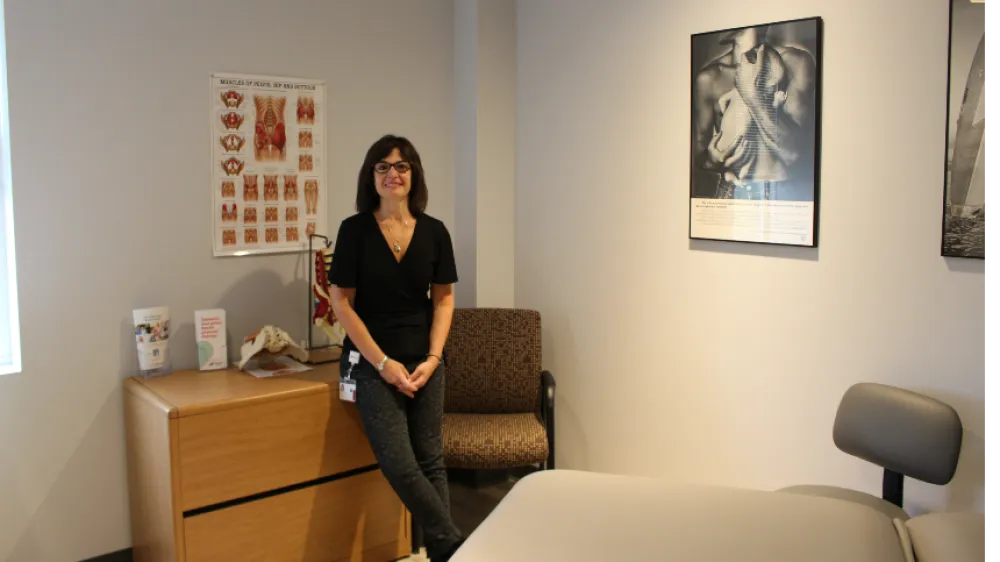Providing your location allows us to show you nearby locations and doctors.
Pelvic floor physical therapy for endometriosis

03/21/2024
By Carolyn Winuk, Doctor of Physical Therapy
Endometriosis is a chronic condition estimated to affect at least 10 percent of women of reproductive age worldwide. Endometriosis is characterized by growth of tissue outside of the uterus that resembles uterine lining tissue, often infiltrating pelvic and abdominal tissues such as ovaries, fallopian tubes, bladder and bowel.
This tissue undergoes changes each menstrual cycle, resulting in inflammation and pain. Research supports that endometriosis is a “menstrual cycle dependent, estrogen-driven, chronic, inflammatory, systemic disease that commonly presents as pelvic pain.” It is most commonly seen in women between the ages of 18 to 45.
There are many ways to manage the pain associated with endometriosis, among them pelvic floor physical therapy. While pelvic floor physical therapy cannot “cure” endometriosis, it is an effective, well-documented conservative treatment option for alleviating and managing associated symptoms.
How does endometriosis cause pelvic floor dysfunction?
Chronic inflammation and adhesions in the pelvic and abdominal cavities can produce pelvic floor dysfunction, as well as pain and movement disorders of the lumbosacral spine and pelvis. Altered mobility of the organs, muscles and fascia, impaired circulation to tissues and chronic tightness, spasm and/or myofascial trigger points can produce pain and altered bowel, bladder, and/or sexual dysfunction.
A skilled pelvic floor rehabilitation specialist can utilize a wide array of treatment techniques and strategies to reduce pain and dysfunction and to help improve the quality of life of patients with endometriosis.
Related content: Putnam Hospital opens women’s physical therapy program
How can pelvic floor therapy help with endometriosis?
When the abdomen and pelvic floor muscles tighten to guard against pain, or have had their integrity altered by surgery, they can produce secondary effects such as painful intercourse, difficult or painful urination and constipation or straining to evacuate stool. Physical therapists are trained in various treatment techniques to help reduce these and other associated bothersome symptoms.
Learn more about endometriosis at Nuvance Health.
Relaxation techniques such as diaphragmatic breathing, guided visualization strategies and passive (therapist-mediated) or active (patient-mediated) stretching, massage and myofascial release can all help to alleviate pain, tightness and calm a hypersensitive nervous system response. In addition, electrical stimulation is a modality that uses safe levels of electrical current delivered through the skin to reduce pain, inflammation and improve circulation. In the presence of a surgical incision, scar mobilization can help restore the normal tissue mobility.
Related content: Women’s physical therapy
Biofeedback, a non-painful treatment technique that uses special equipment and visual/auditory cues to help patients better understand the activity of their pelvic floor, can help improve a pelvic floor dysfunction that may be contributing to pain, bowel and/or bladder symptoms. In some states, physical therapists may also treat trigger points by using dry needling to reduce pain and tightness. Visceral mobilization is a technique that helps to improve mobility of the tissues around the organs and fascia of the abdomen and pelvis, areas that may be affected by adhesions. Finally, all pelvic health physical therapists work to educate patients about lifestyle management: necessary adjustments to exercise, fluid, and bowel or bladder habits to allow for reduced impairment and improved function.
Learn more about pelvic floor physical therapy at Nuvance Health.
Carolyn Winuk, a Doctor of Physical Therapy, practices Pelvic Health Physical Therapy at Putnam Hospital’s Outpatient Rehabilitation Department. She is a Certified Pelvic Rehabilitation Practitioner (PRPC) and is board certified in Biofeedback for Pelvic Muscle Dysfunction (BCB-PMD). She has been in practice for more than 34 years and specializes in the treatment of female pelvic floor dysfunction.